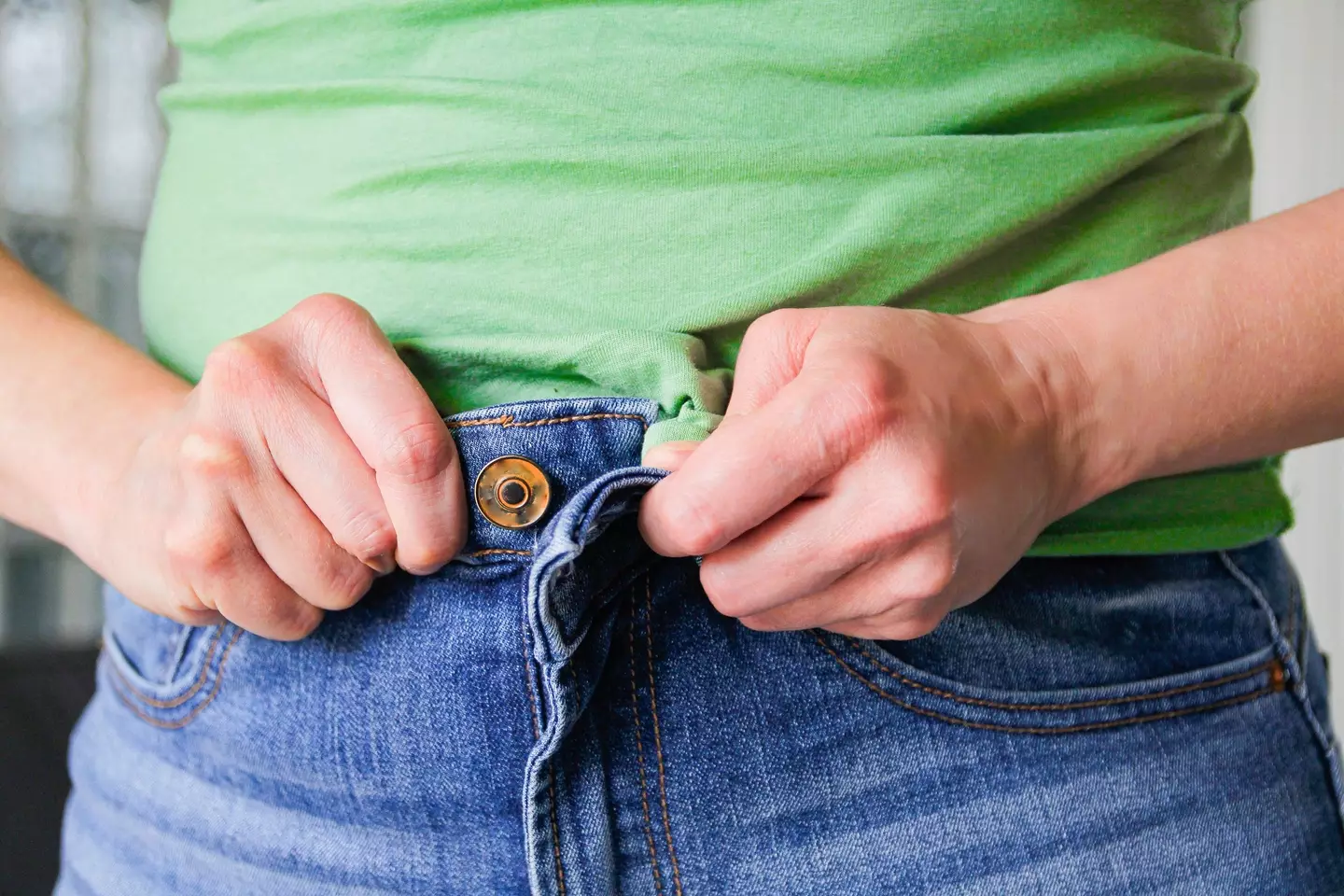Experts explain what happens to your body when you eat one meal a day after shocking simulation shows physical change
Fad diets are nothing new, but some take things to the extreme.
These days, with weight loss drugs like Wegovy grabbing headlines and more people laser-focused on health and body goals, the conversation around how we eat is shifting fast.
Sure, you’ve got your usual suspects like WeightWatchers or the ever-trendy keto diet. But for some, those options just don’t cut it. So, they’re turning to more drastic measures to drop pounds – and fast.
Take, for example, this jaw-dropping simulator that shows what happens to your body when you go without food for 36 straight hours.
Then there’s OMAD, short for the ‘One Meal A Day’ diet.
It’s a slightly less-extreme – but still pretty hardcore – method people are using to try and hack their way to weight loss.
But does it actually work? And is it worth the hunger pangs?
What does OMAD do to your body?

OMAD could deliver results – but is it worth the risks? (Olha Danylenko/Getty Images)
While OMAD is definitely not a magic solution, early research suggests it could help some people reach their weight loss goals.
It’s part of a broader category of intermittent fasting, which has shown promise in helping people lose around seven to 11 pounds over the course of 10 weeks, as per WebMD.
Fat loss and metabolism
OMAD does have its potential benefits, including fat loss. In some studies, participants who tried eating just one meal a day ended up with lower levels of total body fat, even if they didn’t see major changes in overall weight, WebMD reports.
There’s also evidence that time-restricted eating – similar to OMAD, but not as strict – can improve metabolism.
For example, men with obesity and prediabetes who followed a six-hour eating window and fasted the rest of the day saw improvements in their blood sugar levels.
However, since they weren’t doing strict OMAD, we can’t say for sure the same effects would happen with just one meal a day.
Your brain

You, after eating only one meal day, apparently… (Getty Images)
Another interesting potential perk? Mental clarity.
Fasting during daylight hours may boost a brain chemical called orexin-A, which can make you feel more alert and focused.
Which is surprising, considering how cracky I get when I miss just one meal a day.
That said, this benefit isn’t specific to OMAD, but it depends on when you choose to eat.
In fact, research suggests that eating earlier in the day and fasting overnight might be more effective for weight loss than eating your one meal at night, though OMAD itself doesn’t prescribe a specific time for eating.
Blood pressure
Unsurprisingly, OMAD carries a number of potentially dangerous health risks.
Eating only once a day has been linked to higher blood pressure and cholesterol, which leads to an increased risk of heart attacks and strokes.
In one study, healthy adults who switched to OMAD saw both these levels rise – not exactly ideal if you’re already keeping an eye on heart health.
Blood sugar

OMAD can interfere with blood sugar levels (BSIP/Universal Images Group via Getty Images)
Timing matters, too. Some versions of OMAD have people eating their one meal between 4pm and 8pm – and that late-night feast could spike your blood sugar.
Participants in those studies woke up with elevated morning blood sugar, and their bodies struggled to handle the sugar load.
Fasting in general raises your risk for hypoglycemia, or dangerously low blood sugar. That’s not something to mess around with, especially not if you’re at risk of Type 2 diabetes.
Hunger levels
On top of that, eating just once a day can increase levels of the hunger hormone ghrelin, making you feel even hungrier than you would on a typical calorie-cutting plan.
Results aren’t guaranteed
OMAD is a pretty intense commitment, yet there’s no strong scientific consensus that eating one meal a day leads to better long-term weight control compared to more balanced approaches.
Whether or not it works may depend heavily on how your body handles such a restrictive eating pattern.
It’s also not easy to stick with. Studies show that intermittent fasting plans like OMAD have a dropout rate as high as 65 percent, which suggests many people find it too hard to maintain.
Featured Image Credit: Carol Yepes/Getty Images
Topics: Health, Mental Health, Science

A social media user has spoken about their journey trialing one meal a day and highlighted the benefits they found from doing so.
With many people focused on their health and weight, it can be a little bit difficult to know what diet is best for you.
And while there are many options available, some simply don’t seem to work for one reason or another.
Discussing one of the most popular – the one meal a day diet – a Reddit user revealed their strict diet plan and explained how well it worked for them.
Although it is easy to understand why most wouldn’t want to give it a go given the fact its well below the healthy amount of food you should be eating in a day.
The person outlined the rules, stating that he went from intermittent fasting for six months to one meal a day, and of that one meal, they don’t have sugar, rice, bread, carbs, or junk food (what else is there?!).

Losing weight can prove to be difficult for many (Getty Stock Image)
They added that it was similar to a keto diet in that all of their carbs come from natural vegetables and fruits.
They explained: “I do coffee in the AM and some tea in the afternoon. I feel super hungry by about 6 but found that I really don’t eat much when I sit down. A few bites can hold me over until the next day.
“I did also did try a psuedo 48 hour run. ( had about 100 calories over 2 days). Not as hard as you think. I could probably make it 3. Eventually I want to get to a 48 hour fast a week, or even two. I found for me, getting started on the weekend was easiest.”
100 calories over two days is significantly below the healthy and recommended calorie intake for both men and women.
According to the Cleveland clinic, there can be slight fluctuation in how many calories should be consumed due to activity level and age, but it is genuinely recommended that a person under the age of 50 should consume 1,800 to 2,400 calories a day.
The Reddit user insisted that doing this allowed them to lose weight significantly and said it helped keep the process simple and focused.

The user insisted the one meal a day method helped them shed lots of weight (Getty Stock Image)
A simulation showcasing how the body behaves without food has shown that without intake (food) the body can quickly start to shed weight and burn through fat for energy.
They added: “For me it is for weight loss. Regardless of what anyone tells you,. Everything is about reducing calories. You don’t need an app, special diet plan, etc I am down 35 lbs. Still have 80 to go but it no longer seems impossible. Basically, you just need to reprogram your brain to not use food as reward, pleasure, etc. It is simply a fuel to keep going.”
But before you go and give any old diet a go, it is probably best to speak to a healthcare professional and let them know your goals and intentions.
OMAD is a pretty intense commitment, yet there’s no strong scientific consensus that eating one meal a day leads to better long-term weight control compared to more balanced approaches.
Featured Image Credit: Getty Images/Westend61
Topics: Food and Drink, Health, News, Reddit

A simulation has revealed that the human body has a mega transformational change when you stop eating sugar for two weeks.
Sugar is considered a main perpetrator behind the obesity crisis in the US, and you don’t need me to tell you that excess consumption of the sweet stuff isn’t good for your teeth, either.
Doctors have long warned that the American diet, characterised by sugar-sweetened beverages and similarly sugar-laden snacks, can lead to type two diabetes as well as a myriad of other chronic diseases.
It’s clearly in our best interests to reduce our intake if we’re to live a long, healthy life, though that’s easier said than done when it comes to cleansing our diet of it completely.
This is because, much like addictive drugs, sugar tickles the reward (pleasure) part of our brains, releasing the hormone dopamine, which makes us feel happy and, in turn, keeps us craving it more and more.

Sugar tastes nice and gives us a dopamine hit too (Getty Images)
Complicating matters, not all sugars are ‘bad.’
Health explains natural sugar in dairy, fruit, and vegetables is different from the added, artificial sugars piled into processed foods – and only the former ticks all the boxes when it comes to fibre, vitamins and minerals that we need to support our overall health.
Still, while sugar is a pretty tough habit to kick to the curb, it’s not out of the realm of possibility as one viral simulation by @GrowfitHealth shows.
Examining the effects under a microscope, the simulation reveals that the body does eventually learn to cope without its dopamine crutch by the end of two weeks, but grapples with some major transformative changes from one day to the next.

The simulation shows the body has some major changes almost immediately after quitting sugar (@GrowfitHealth/YouTube)
What happens to your body after quitting sugar?
The first two days of no sugar
The video shows that in just 48 hours of quitting sugar, the body’s blood sugar is already starting to stabilise and you’ll see ‘lesser energy crashes or sudden spikes.’
You might even see the number on the scale go down as studies reveal the body releases stored water when the sugar train is cut short.
The simulation adds that within two days, ‘your body starts tapping into stored fat for energy’.
Day three to six of no sugar
Although you might feel a slight buzz in the beginning, especially if you feel like you’re losing weight and you’re not feeling that post-lunch slump, withdrawal symptoms will soon turn to bite you somewhere between days three to six.
“You may experience headaches, mood swings and fatigue,” the video reveals before you even make it to the week mark. “This is because your body is detoxifying and adjusting.”
However, it comfortingly adds: “These symptoms will pass.”
This is backed up by the experts at Addiction Help, who write: “Common symptoms in the early stages of sugar withdrawal include physical symptoms like headaches, fatigue, and nausea. Mental symptoms include irritability, anxiety, mood swings, and generally worsened mental health.”

Mood swings can kick in when your brain feels deprived of sugar (Getty Images)
A week no sugar
Between days seven to nine, studies show that foggy feeling will begin to wind down and you’ll be rewarded with a new lease of life as whole foods all of a sudden taste better.
As per the simulation: “Your palate becomes sensitive to subtle flavors and you’ll find fruits tasting extra sweet.”
Two weeks no sugar
Finally, on the home stretch between 10 days up to the two-week mark, there’s a high chance you’re feeling energetic, banking a good night’s sleep and reaping the rewards of weight loss.
The simulation states energy ‘shoots up and you’ll notice no more sugar crashes,’ instead ‘just steady, clean fuel as your body becomes more efficient at burning fats for your fuel.’
What are the benefits of quitting sugar?
As well as weight loss, EatingWell finds other benefits to eating less added sugar can reduce the chances of developing depression, anxiety or other mental health illnesses.
Other studies have also suggested that a sugary diet is closely linked to cardiovascular diseases due to its propensity to raise blood pressure and increase inflammation.
To break free from so-called sugar addiction, the Cleveland Clinic advises never to skip a meal, drink lots of water, get plenty of sleep and to eat at least five servings of fruits and vegetables a day.
Making time for exercise to combat those stress hormones that trigger mood swings is also a good idea.
Featured Image Credit: @growfithealth/YouTube
Topics: Health, Mental Health, Fitness, World News, Food and Drink

It’s no secret that vaping isn’t exactly good for us, but what actually happens when we ingest the chemicals has been brought to life in a terrifying simulation.
The consequences of long-term vaping to our health are yet to be discovered, according to the NHS, yet the world is gripped with vaping horror stories.
Take for instance one man who was given a one percent chance of survival after becoming addicted to vaping – or the fact a 17-year-old had to have a tough surgery to remove part of her lung after vaping the equivalent of 400 cigarettes per week.

Vaping isn’t exactly good for us but research is in its infancy (Michael M. Santiago/Getty Images)
Although the science is currently lagging behind on what is essentially a relatively new phenomenon, we do know vaping can be highly addictive, due to the nicotine involved.
The NHS says: “Research on vaping related harm is rapidly developing. Current evidence suggests vapes are less harmful than smoking tobacco products, but they aren’t risk free.
“Most vapes contain nicotine, which is highly addictive. They also often contain other ingredients like propylene glycol, glycerine and flavourings.”
Now, a new YouTube video has revealed exactly what happens when the chemicals from a vape enter the body, and it makes for a bit of an uncomfortable watch.

The simulation shows what happens to the lungs when vaping (YouTube/The Infographics Show)
The educational video, created by The Infographics Show, shows how chemicals target the lungs and create a build-up on the mucus on the alveoli – which we need for oxygen.
The simulation explains the chemicals have a ‘paralytic effect’ on the lungs and the cilia, which takes weeks to recover from.
Once the cilia is damaged, medics say the body could be susceptible to more infections and illnesses.
Experts say a major concern for vaping products is due to its various flavors and styles, attracting the eyes of teenagers and under 18s.
A scientific study in 2023 found that 4.6 percent of middle school students (age 11-14) and 10 percent of high school students (age 14-18) have said they have used e-cigarettes or vapes, according to the CDC.
In the US, this equates to almost 2.13 million students.
While studies on the detrimental effects on long-term vaping are still in its infancy, some research is beginning to acknowledge the damage.
A recent study published online in The Journal of Nuclear Medicine observed participants who were e-cig users and non-smokers to compare lung inflammation.
It was found that e-cigarettes were associated with lung inflammation and inflammatory lung disease, which, according to Very Well Health, can cause wheezing, breathing problems, and chest pain and tightness.
Featured Image Credit: Getty Stock Images
Topics: Health, Science, Education, YouTube, NHS, Vaping, Technology, US News, UK News

Health experts have warned of six ways eating excess sugar can impact your body – and they’ll probably make you think twice about reaching for that donut.
We all know by now that eating too much of anything, particularly sugar, is bad for us -everything in moderation, as the old saying goes.
And while there are certain times of the day that eating sugar actually increases our pleasure and sees less impact on our body, we should still be mindful of how much of it we consume.
The American Heart Association recommends men should consume no more than nine teaspoons of the white stuff a day – which is around 36 grams, or 150 calories.
Women, meanwhile, should consume no more than six teaspoons, so 25 grams or 100 calories.
While that sounds like a lot, unless you keep track of your diet, chances are, with all the added sugar in food and drinks nowadays, you’re probably consuming more without even realizing it.
And with that in mind, let’s take a look at the six ways too much sugar can impact our health.
Liver

The liver can be hit hard by excess sugar (Sebastian Kaulitzki/Science Photo Library/Getty Images)
You might instantly think of alcohol when it comes to the liver, but it’s not just booze that’s bad for our organs.
Your liver actually metabolizes sugar as it does alcohol, as experts at Dartmouth Health explain, converting carbohydrates to fat.
But the accumulation of fat could cause ‘fatty liver disease,’ which can in turn lead to diabetes and raise your risk for heart disease.
Gut health

Feeling bloated after sugar? This is why… (PixelsEffect/Getty Images)
Our gut can also take the brunt of sugar-binges, ultimately making us feel slow and sluggish.
High-fructose corn syrup (HFCS), found in candy, soda and packaged sweets, is particularly bad for our guts.
Jean Copeland, registered dietitian and nutritionist at DHMC’s Heart and Vascular Center, explains: “When you consume HFCS, a less efficient method of absorption takes place, leaving unabsorbed sugar in your small intestines.”
Fluid is then drawn into the gut from the bloodstream, bloating and gurgling in the abdomen.
The sugar eventually moves to the colon, where bacteria ferment it, causing gas or diarrhea.
Teeth

Sugar rots our teeth, causing a whole host of irritating and painful problems (Boy_Anupong/Getty Images)
We’ve had it ingrained into us since we were kids that sugar rots our teeth.
Sugary drinks, dried fruit, candy and chocolate are common offenders, with acidic sour candies among the worst, WebMD explains.
Sugar works by feeding the bacteria in our mouths, which ‘leave behind acid that wears away your tooth enamel.’
This causes our teeth to become weaker, more sensitive and oftentimes appear more yellow in color.
WedMD recommends rinsing your mouth with water or drink after a sweet treat to neutralise the acid.
Weight gain

Diets high in sugar can lead to weight gain (Kinga Krzeminska/Getty Images)
We all know that eating too much of anything can contribute to weight gain, but sugar is a particularly dangerous culprit.
Shockingly, if you drink a can of soda every day and don’t trim the calories elsewhere, you’d be 15 pounds heavier in three years, WedMD says.
It’s no secret that high-sugar diets can lead to obesity, which then increases your risk of developing conditions including diabetes, heart diseases, strokes and even certain types of cancers.
Skin

The negative effects of sugar can be seen in our skin (Maksym Belchenko/Getty Images)
A less obvious area sugar can impact us is our skin.
Dr Nish from Unity Point Health explains how our skin is composed of collagen and elastin, which make our skin supple and soft.
But pesky sugar causes a ‘cross-linking of collagen,’ which results in stiffening and loss of elasticity.
So, the more sugar we eat, the more our skin suffers.
Sugar could also cause ‘increased acne, appearance of wrinkles, sagging in neck and chin and the development of dark spots,’ Dr Nish adds.
Mental health

Sugar can even interfere with our mental health (Urbazon/Getty Images)
Having a sweet tooth could also see you struggle more with your mental health.
WebMD reported that a recent study showed men who ate more than 66 grams of sugar a day – that’s almost double the recommended amount – were 23 percent more likely to be diagnosed with anxiety or depression than men who ate 40 grams or less.
Scarily, excess sugar could also stoke up depression by causing inflammation in the body and even the brain, which is more common in people with depression.
Other studies suggest that unstable blood sugar can also play a part in unstable moods.





